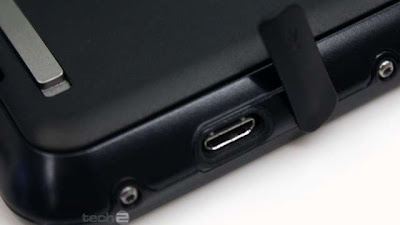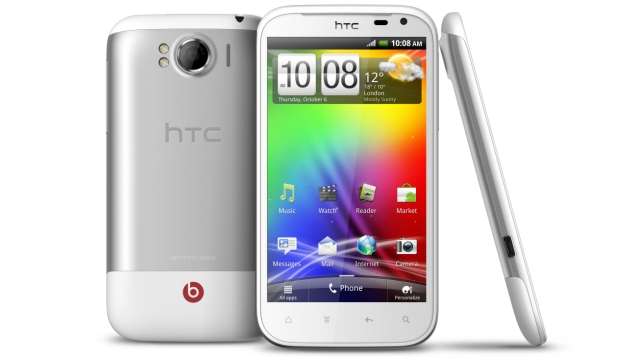RIM recently announced two new entry-level BlackBerry devices, the Curve 9380 and the Bold 9790, to limited fanfare; they were, after all, just cheaper versions of the Torch 9850/60 and Bold 9900. Still, that’s just what some people are looking for, especially in places like Indonesia where the BlackBerry spirit is still strong, but device cost is a significant bottleneck.
After getting a quick tour of the new phones at RIM’s campus last week, they sent me home with the Curve 9380 to review. Having recently come off reviewing the new Torch, it didn’t feel like there was a lot new with this one, but there were a few small tweaks that give the Curve 9380 a distinctive spot in the BlackBerry lineup; whether that translates to any appeal in the smartphone market at large is another question altogether.
HARDWARE
The front face of the BlackBerry Curve 9380 consists mainly of the 3.2-inch 480 x 320 touchscreen, which is identical to the Torch 9800 launched in the summer of 2010. Unlike its predecessor, the Torch 9850 / 60, the navigation keys next to the optical trackpad are built right into the screen, and click down in a frighteningly Storm 2-esque fashion. Aside from that, the BlackBerry Curve 9380 follows very closely in the established style by other OS 7 handsets launched so far this year.
From a specifications perspective, the 9380 is about on par with the keyboard-clad Curve 9350 / 60 - 800 MHz processor, near-field communications support, augmented reality apps thanks to a magnetic compass, and the usual fare like HSPA, Bluetooth, NFC, and Wi-Fi b/g/n wireless connectivity.
DESIGN
Most of the lines of the BlackBerry Curve 9380 follow closely in step with the Torch 9850 / 60. The side convenience keys are in the new sliver style that I really like. It minimizes the footprint on the side of the phone, but are still sharp enough to be distinctive and easy to navigate in the pocket. The single lock key on the top takes just enough pressure to activate, which is important if you want to avoid accidentally unlocking your phone in your pocket.
I'm still not sure how I feel about having the headphone jack on the top. When you have the Curve in your pocket, it makes perfect sense, but if it's resting on a desk while you're listening to music, the phone will have a tendency to turn upside down on you, which can be inconvenient if you're regularly checking for e-mails. At the very least, the volume controls double for track navigation with long presses, so if you're using the Curve exclusively for music, the upside-down thing isn't a huge deal.
On the whole, I dig the style of the BlackBerry Curve 9380, namely because those front keys are flush with the main screen. The whole package is nicely streamlined and intelligently laid out.
BUILD QUALITY
Even among BlackBerry handsets, which tend to be pretty plasticky, I wasn't particularly happy with the build quality of the BlackBerry Curve 9380. The silver-coloured bezel is just creaky enough to cause concern, for one. It's not a huge worry now, but it's easy to imagine it getting even looser over time. The polished battery door quickly gathers nicks and scratches, losing its new-feel polish. Even the front screen was prone to a couple of minor scratches; nothing so bad as to impair display visibility, but I could see them piling up over time without additional protection. That battery door is also a pain to remove using the designated indentation on the left side. I generally tend to pry from above the convenience key on the other side.
CAMERA
Overall, I've seen much better performance from 5 megapixel cameras. The fact that it's extended depth of field rather than the usual autofocus means close-ups are pretty much a lost cause. This is something we've seen in the past with the BlackBerry Bold 9900, and as far as I'm concerned, isn't worth sacrificing for the sake of slimness or cost.
Besides that, I've found even long-range landscape shots produce a lot of noise. At the very least there's an LED flash on there for low-light situations, but I wouldn't classify the 5 megapixel camera on the BlackBerry Curve 9380 much higher than "functional". Here are a few samples. Video quality wasn't really worth sharing, since resolution is down around 640 x 480.
SOFTWARE

The BlackBerry Curve 9380 comes loaded with OS 7.0.0.482, which includes the usual additions, like voice recognition within universal search, support for 3D graphics, near-field communications (though that's dependent on carrier cooperation) and augmented reality apps. App World has been updated with a new user interface, and selection is decent, though the quality won't be anywhere near what you'll see in the Android Market or iPhone App Store. Though RIM is still dishing out free apps for the service outage until the end of December, BlackBerry apps haven't yet been updated with 9380 compatibility, so selection is a bit limited. Some of my favourites, like GetGlue, Foursquare, and Poynt work fine in any case. Most of the best apps are made by RIM, actually, including BlackBerry Travel, which automatically populates your calendar with travel itineraries as confirmations come in via e-mail. Another good one is BlackBerry Protect, which offers a helpful suite of security utilities, like tracking your phone's location by GPS, and remotely wiping your phone should it get into the wrong hands.
BlackBerry faithful will miss the physical keyboard when using the Curve 9380. The SureType layout works reasonably well in portrait orientation, but typing accuracy still isn't quite as smooth as I would need on a daily basis. Switching over to the classic QWERTY layout works well enough in landscape orientation, and even in portrait can sometimes be more accurate than SureType. I often had to backtrack to correct words, sometimes more than once. Android definitely has a lead with gesture-based keyboards like Swype.
The BlackBerry experience still revolves primarily around messaging, including e-mail, texts, social networking, and instant messaging. They're all fed through one central app, and easily accessible through a smart notification system.
In terms of overall performance, I found that the only time the 800 Mhz processor really chugged was when installing an application; at those times, you pretty much can't do anything with the Curve 9380, but for the rest of daily usage, I found the 9380 to be snappy and responsive.
MULTIMEDIA
The 3.2-inch 480 x 320 display is big enough and sharp enough to watch shows up to about a half-hour without going bleary-eyed, though you won't experience the same degree of luxury you might enjoy on a bigger, higher-end phone. The picture sharpness might not be quite up to snuff if you're accustomed to a higher-end device. I can't get several .MOV files to play, but it can handle 720p MP4 video files just fine.
As for music, there's not much new. You can store tunes locally on the microSD memory card, or stream through apps like Slacker or Rdio. There's full playlist support in the native media app, and the media control keys along the right side offer quick volume and track skipping. BBM Music is there if, for whatever reason, you want to shell out $5/month to listen to music picked by random fellow subscribers mixed in with 50 of your own picks. I always found RIM's Podcasts app pretty helpful for always keeping up-to-date entertainment on my phone.
Besides that, the 3D graphics support does enable a few games, though selection is still fairly limited. In this screenshot, you can see PBA Bowling 2 in action.
BROWSER
The BlackBerry OS 7 browser is based on WebKit, and has full tab and pinch-to-zoom support. There's no Flash, and with Adobe switching gears to supporting apps written in Flash rather than browser plug-ins, we're going to have to rely on RIM to keep the browser up-to-date when BBX rolls around. As for rendering performance, the browser on the Curve 9380 score an average of 17813 on BrowserMark; by comparison, the iPhone 3GS running OS 4.2.1 generally scores around 26000. The HTML5 test scored 260 + 3 out of 450 total points, and 100/100 on the Acid3 test (which primarily measures JavaScript performance) with a slight artifact in the top-right corner.
CALL QUALITY AND BATTERY LIFE
The BlackBerry Curve 9380 has the same 1230 mAh JH-1 battery as the Curve 9350 / 60, and since it has a comparable processor speed and screen resolution, it shouldn't be any surprise that it can barely get through a full day on a single charge too. Generally, the 9380 lasted until the early evening after a moderate day of usage. If you end up getting the 9380, be sure to have somewhere to charge it mid-day to stay connected. RIM advertises 5.8 hours of talk time over 3G, 15 days standby, 30 hours of continuous audio playback, and 5.5 hours of video.
Call quality was par for course, and I didn't experience any dropped calls on the Rogers network in Ottawa. The phone application consists of three tabs: the number pad, recent call log, and address book. There's a shortcut to launch into your voicemail, as well as the ability to append text notes to call log entries. Speakerphone quality is passable, though there's only one sound port on the rear, near the bottom; typically, I see better sound quality from multiple sound ports.
THE FINAL TAKE
While the BlackBerry Curve 9380 takes knocks on a few fronts, it does perform fairly well for its price. Right now, the only carrier that has gone public with its pricing for the 9380 is TELUS, and they're asking $50 on a three-year contract. It does follow very closely in the footsteps of the Torch 9850 / 60, and despite a processor downgraded to 800 MHz, killing autofocs on the camera, and reducing the screen quality, the 9380 still provides a familiar, responsive experience. The 9380 even has a bit of a leg-up on the Torch by including NFC.
The real problem here is that anything shy of a next-gen BBX handset from RIM won't deter consumers from migrating to iPhone and Android. Any BlackBerry smartphones released until then will only really appeal to those already steeped in the BlackBerry lifestyle, and those folks will most likely drift towards a traditional RIM device with a physical keyboard. Those willing to eschew it will at least want to have high-end features, and so lean towards the Torch 9850 / 60. This leaves a tiny cross-section of consumers who place a high value on messaging (but not so high as to make a physical keyboard a requirement), and are on a budget, but still want a respectable multimedia experience. If there wasn't enough confused targeting there, RIM's branding strategy now has more to do with specs rather than form factor, which may throw folks for a loop who may confuse this phone with a Torch or a Storm.










































































